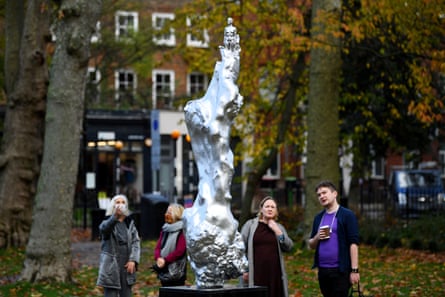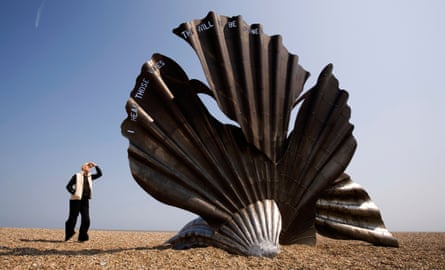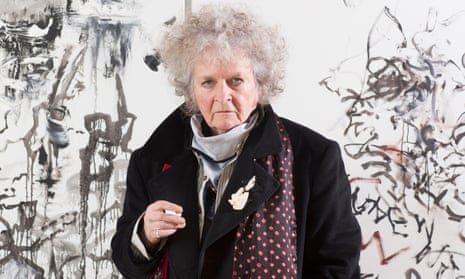Maggi Hambling is listing her favourite sculpted penises. “The Elgin marbles,” she says. “Michelangelo’s David. And Shelley’s, though it is rather small.” She means the Shelley memorial, Edward Onslow Ford’s attempt to depict the sea-shrunken corpse of the drowned poet. She takes a drag on her cigarette, exhales and giggles.
We’re sitting on the pavement outside the Marlborough Gallery in Mayfair so Hambling can have a cigarette. It’s stupidly cold but this is the only place we can do the interview, unless the artist quits. And that’s not going to happen. She is an incorrigible smoker, refusing to be photographed without a cigarette in hand. Until recently, the gallery made an exception, allowing Hambling to light up inside. “But the people in the offices above objected to the smell,” she says. “They threatened to close down my show.” So she has evicted herself from her own exhibition for the length of four cigarettes and a coffee.
Why are we talking penises? Because I asked Hambling to address the critics of her statue of Mary Wollstonecraft, the feminist icon and mother-in-law of Shelley. It was unveiled last month in Newington Green, north London, sparking an instant furore. The hostile response, which came in no small part from feminists who had waited a long time to see their heroine honoured, was provoked by the tiny, naked and luxuriantly bushed figure of Wollstonecraft crowning Hambling’s sculpture. A piece in the Guardian was headlined: “Why I hate the Mary Wollstonecraft statue: would a man be ‘honoured’ with his schlong out?”

Hambling replies: “Oh, but there are plenty of schlongs honouring men in art.” This is true. But not far from this spot, on the facade of the Royal Academy, four male philosophers – Francis Bacon, Gottfried Wilhelm Leibniz, John Locke and Adam Smith – are all honoured fully clothed. The feeling was that the work played to the male gaze, offering yet another obligingly passive and implausibly perky female nude. So shouldn’t Hambling have honoured the author of A Vindication of the Rights of Woman with her clothes on? “The figure had to be nude because clothes define people,” she says. “Put someone in country tweeds and they become horsey. Put someone in period dress and they become part of history. I didn’t want to do that to her.”
She adds: “I wanted to capture the spirit of Mary Wollstonecraft and the struggle for the rights of women. It’s a struggle that goes on – and so the figure is a challenge to our world.”
The controversy doubtless helped make Wollstonecraft better known. Bee Rowlatt, author of In Search of Mary, was among the women who had campaigned for a statue. She pointed out that millions read about Wollstonecraft because of the outcry.
Hambling knows from experience that anything can happen once her art leaves her studio. “It goes out into the world and I’m not in charge of it any more.” Yet she feels that a lot of the commentary missed the point. The idea, as Rowlatt explained, was to represent the birth of a movement, rather than Wollstonecraft herself. The hope, too, was to get away from putting people on pedestals.

But if that were true, shouldn’t Hambling have done something more akin to, say, Kathryn Gustafson’s Hyde Park memorial to Princess Diana, a fountain deliberately conceived as anti-phallic and anti-representational, albeit one that Britons swiftly diminished by washing their dogs in? “Well, I suppose you could say my sculpture is phallic. Somebody said to me, ‘It’s like a skyrocket going up.’ I like that.”
Certainly, Hambling’s Wollstonecraft is not so much resting on a pedestal as rushing skywards on a froth of mysterious matter. That matter, Hambling explains, represents the fight against the patriarchy. “The tower the figure rests upon refers to the struggle of women. They are mingling female forms.” As she points out, many of the articles damning her sculpture cropped out that context to focus on the nude figure. Would she have done Wollstonecraft differently had she known the uproar it would cause? “No,” says the artist. “I couldn’t. I’m not in control of what I do. The subject speaks through me when I work.”

A recent BBC profile of Hambling was called Making Love with the Paint. What does she think of the title? “That’s really what’s it’s about, falling in love, then making love using the silly old medium of oil painting.” Or, in the case of Wollstonecraft, silvered bronze. She calls this the erotics of the studio and it’s why she won’t be filmed or photographed at work. “I don’t want to be looked at while I’m fucking, nor when I’m working. The studio is where my real life is. The rest of life is – well, less intense.”
This erotic charge is why Maggi never painted Maggie. “I felt no empathy with Margaret Thatcher,” she says, “so I turned down the commission. She had very little heart.” She felt more connection with Dorothy Hodgkin, the British biomolecular chemist who won a Nobel prize in 1964. Hambling’s painting of her now hangs in the National Portrait Gallery. “She invited me to her home and said she would sit for me in the garden or in the house. But I realised that I needed to paint her at work to be true to be spirit.”
Hambling is used to controversy. In 1998, another bronze, A Conversation with Oscar Wilde, faced derision from critics when it was unveiled in London’s St Martin in the Fields. The Irish writer’s face emerges from one end of the bench-like structure, which bears a quote from Lady Windermere’s Fan that may resonate with the area’s many rough sleepers. “We are all in the gutter,” it reads, “but some of us are looking at the stars.”

The last time I interviewed her, 16 years ago, Hambling’s portrait of Michael Jackson had been turned down for the Royal Academy’s summer exhibition because it came with a note explaining that the artist thought the singer was innocent of child abuse charges. This followed another row – over Scallop, her 12ft-tall sculpture erected on the beach at Aldeburgh in 2003, to honour her Suffolk icon, the composer Benjamin Britten. There was a petition against Scallop which, once unveiled, was covered with dull-witted graffiti, some of it homophobic. Hambling now claims it has been responsible for a tourist boom – and rocketing sales of fish and chips and ice-creams.
The artist learned to shrug off criticism early. At the age of 14, she turned her bedroom in Hadleigh, Suffolk, into a studio and painted the night sky from her window. When she arranged the resulting paintings before schoolmates, they laughed. Her art teacher, Yvonne Drewry, asked their sobbing creator what was the matter. When she was told, Drewry said: “Criticism has got to be water off a duck’s back.”
“That has stayed with me,” says Hambling, “as has another remark I heard a year later.” This came from the sculptor Arthur Lett-Haines, another tutor. “He told me you must make your work your best friend. That’s easier to say than do, but it is how I have lived my life.” That must be disappointing for her lovers to hear? “Oh, don’t worry about that,” she says with a wink. “I’ve done all right with lovers.”
Most memorably she had an affair with Henrietta Moraes, muse of painter Francis Bacon. In the introduction to a book of Moraes portraits, Hambling wrote: “Henrietta began to pose for me at the end of May 1998. I became her subject rather than she mine. She seized power as ruthlessly as a Borgia. Her death in January 1999 left me with ‘unfinished business’ and her confrontational presence continues to fill the studio.”

We go inside the gallery, for a tour of Maggi Hambling 2020, an exhibition of recent paintings coinciding with her 75th birthday. Hambling directs me to a work called Lett. She painted it three years ago, even though Lett-Haines died in 1978. She does this again and again, keeping lost beloveds alive in art. “I agree with Auden,” she says. “Art is our chief means of breaking bread with the dead.”
Nearby is her favourite picture in the exhibition, a complicated self-portrait that includes an empty dog basket to memorialise Lux, her late Tibetan terrier. “After a suitable period of mourning,” she says, “I went to Lux’s grave and asked her permission to get another dog. She said I could.” And so she has: a six-year-old black rescue pug called Peggy. “I never get the same breed otherwise I might compare them unfavourably.”
This exhibition includes the superb Self Portrait (Angry). In a fury of brushstrokes, it expresses how she felt in lockdown. “I had a show in New York and another in Italy, both cancelled. I couldn’t hug anyone. I missed that.”
She leads me upstairs with the words: “You must see the animals.” We enter a gallery full of paintings that include a rhino without a horn, a tuskless elephant, and a chained dancing bear sporting a hideous rictus. She says many of these works are about “how we are fucking everything up”. One, a black canvas overpainted with a vague form, looks like a calf that has lost its mother. It’s called The Last Animal. “Imagine,” she says. “It is the last life in the world.”
We finally come to a black canvas showing a bird in a cage rendered in white. Underneath this picture is a self-portrait that’s been painted over. Why did she do that? “Sometimes I bugger things up. It’s tragic but necessary to paint over things sometimes.” The caged bird has become unwittingly topical, as if the self-portrait has reasserted itself. Hambling gazes at the work and says: “We are all in cages this year.”
